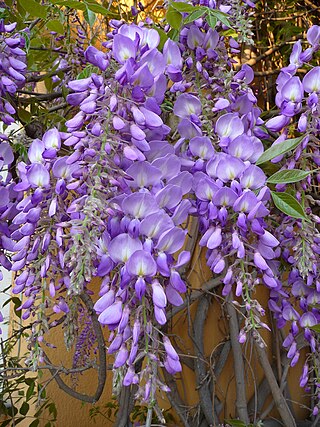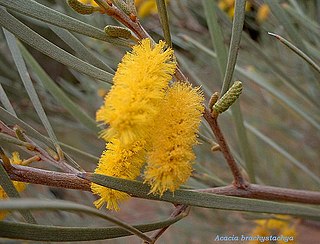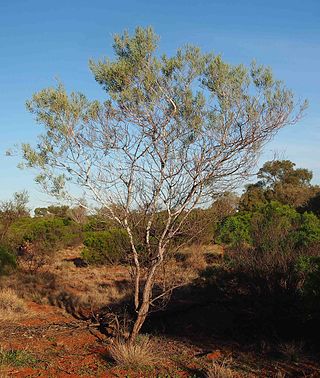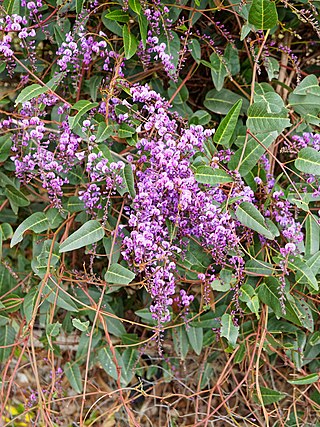
Wisteria sinensis, commonly known as the Chinese wisteria, is a species of flowering plant in the pea family, native to China, in the provinces of Guangxi, Guizhou, Hebei, Henan, Hubei, Shaanxi, and Yunnan. Growing 20–30 m (66–98 ft) tall, it is a deciduous vine. It is widely cultivated in temperate regions for its twisting stems and masses of scented flowers in hanging racemes, in spring.

Acacia pycnantha, most commonly known as the golden wattle, is a tree of the family Fabaceae native to southeastern Australia. It grows to a height of 8 m (26 ft) and has phyllodes instead of true leaves. Sickle-shaped, these are between 9 and 15 cm long, and 1–3.5 cm wide. The profuse fragrant, golden flowers appear in late winter and spring, followed by long seed pods. Plants are cross-pollinated by several species of honeyeater and thornbill, which visit nectaries on the phyllodes and brush against flowers, transferring pollen between them. An understorey plant in eucalyptus forest, it is found from southern New South Wales and the Australian Capital Territory, through Victoria and into southeastern South Australia.

Acacia brachystachya, commonly known as umbrella mulga, turpentine mulga or false bowgada, is a shrub in the family Fabaceae. The species occurs in mulga and heath communities on sandhills and rocky ridges in all mainland states of Australia, except Victoria.

Acacia murrayana is a tree in the family Fabaceae. It has numerous common names, including sandplain wattle, Murray's wattle, fire wattle, colony wattle and powder bark wattle that is endemic to arid areas in every mainland State except Victoria.

Kennedia is a genus of thirteen species of flowering plants in the pea family Fabaceae and is endemic to Australia. Plants in this genus are prostrate or climbing perennials with trifoliate leaves and large, showy, pea-like flowers. There are species in all Australian states.

Hovea elliptica, commonly known as the tree hovea or karri blue bush, is an ornamental plant in the family Fabaceae that is native to Western Australia. This plant was cited as Hovea Celsi in Description des plantes rares cultivees a Malmaison et a Navarre by Aimé Jacques Alexandre Bonpland.

Hardenbergia is a genus of three species of flowering plants in the pea family, Fabaceae and is endemic to Australia. Plants in this genus are climbing or trailing herbs or subshrubs with pinnate leaves with one, three or five leaflets and groups of violet, white or pinkish flowers in pairs or small clusters in leaf axils. Species of Hardenbergia occur in all Australian states and in the Australian Capital Territory.

Acacia longifolia is a species of Acacia native to southeastern Australia, from the extreme southeast of Queensland, eastern New South Wales, eastern and southern Victoria, and southeastern South Australia. Common names for it include long-leaved wattle, acacia trinervis, aroma doble, golden wattle, coast wattle, sallow wattle and Sydney golden wattle. It is not listed as being a threatened species, and is considered invasive in Portugal, New Zealand and South Africa. In the southern region of Western Australia, it has become naturalised and has been classed as a weed by out-competing indigenous species. It is a tree that grows very quickly reaching 7–10 m in five to six years.

Acacia elata the cedar wattle or mountain cedar wattle is a tree found in eastern Australia.

Eremaea is a genus of woody shrubs and small trees in the family Myrtaceae and is endemic to the south-west of Western Australia. Little study of the genus as a whole had been undertaken until Roger Hnatiuk researched Eremaea and published a paper in 1993, A revision of the genus Eremaea (Myrtaceae) in Nuytsia. The first species to be described was Eremaea pauciflora in 1837 and by 1964, the number of species known had increased to 12. Hnatiuk recognised 16 species, 5 subspecies and a number of varieties.

Hardenbergia violacea is a species of flowering plant in the family Fabaceae and is endemic to Australia. It is known in Australia by the common names false sarsaparilla, purple coral pea and waraburra. Elsewhere it is also called purple twining-pea, vine-lilac and wild sarsaparilla. It is a prostrate or climbing subshrub with egg-shaped to narrow lance-shaped leaves and racemes of mostly purple flowers.

Pandorea pandorana, commonly known as the wonga wonga vine or wonga-vine, is a species of flowering plant in the family Bignoniaceae and is native to Australia, Malesia and the southwestern Pacific region. It is a woody scrambler or climber with pinnate leaves, juvenile leaves differing from those of mature plants. The flowers are tubular or funnel-shaped and white with purple markings and the fruit are capsules containing winged seeds. It is easy species to germinate and is a popular garden plant. Common cultivars include the yellow-flowered P. 'Golden Showers', the white-flowered P. 'Snowbells', and the pinkish P. 'Ruby Belle'. The wood was used in making spears for woomeras in the Central and Western deserts.

Persoonia linearis, commonly known as the narrow-leaved geebung, is a shrub native to New South Wales and Victoria in eastern Australia. It reaches 3 m (9.8 ft), or occasionally 5 m (16 ft), in height and has thick, dark grey papery bark. The leaves are, as the species name suggests, more or less linear in shape, and are up to 9 cm (3.5 in) long, and 0.1 to 0.7 cm wide. The small yellow flowers appear in summer, autumn and early winter, followed by small green fleshy fruit known as drupes. Within the genus Persoonia, it is a member of the Lanceolata group of 58 closely related species. P. linearis interbreeds with several other species where they grow together.

Austrocallerya megasperma, one of several species commonly known as native wisteria, is a species of flowering plant in the family Fabaceae and is endemic to eastern Australia. It is a woody climber with pinnate leaves and racemes of purple, pea-like flowers.

Lysiphyllum cunninghamii is a species of plant in the family Fabaceae. It is native to northern Australia where it occurs from Western Australia through the Northern Territory to Queensland.

Acacia spinescens, commonly known as spiny wattle, is a shrub belonging to the genus Acacia and the subgenus Alatae. It is native to New South Wales, South Australia and Victoria.

Acacia huegelii is a shrub belonging to the genus Acacia and the subgenus Phyllodineae native to Western Australia.

Acacia iteaphylla, commonly known as Flinders Range wattle, Port Lincoln wattle, winter wattle and willow-leaved wattle, is a shrub belonging to the genus Acacia and the subgenus Phyllodineae that is endemic to South Australia.

Calandrinia corrigioloides is an annual herb in the family Montiaceae, and is native to Western Australia, South Australia, and Victoria.
Native wisteria may refer to:




















